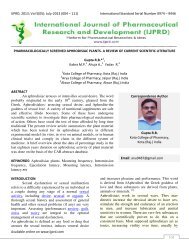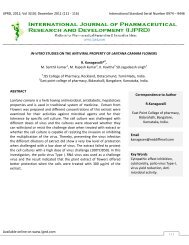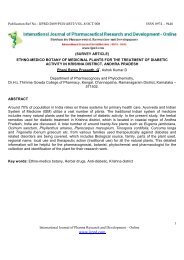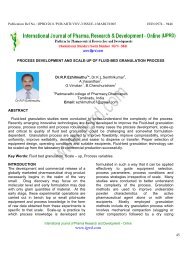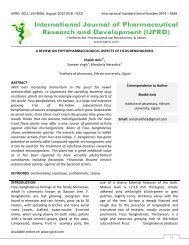INVITRO ANTIBACTERIAL ACTIVITY OF METHANOLIC ... - IJPRD
INVITRO ANTIBACTERIAL ACTIVITY OF METHANOLIC ... - IJPRD
INVITRO ANTIBACTERIAL ACTIVITY OF METHANOLIC ... - IJPRD
You also want an ePaper? Increase the reach of your titles
YUMPU automatically turns print PDFs into web optimized ePapers that Google loves.
Publication Ref No.: <strong>IJPRD</strong>/2010/PUB/ARTI/VOV-2/ISSUE-5/JULY/007 ISSN 0974 – 9446<br />
<strong>INVITRO</strong> <strong>ANTIBACTERIAL</strong> <strong>ACTIVITY</strong> <strong>OF</strong> <strong>METHANOLIC</strong> ROOT EXTRACT <strong>OF</strong><br />
TINOSPORA CORDIFOLIA (WILLD)<br />
ABSTRACT<br />
M. Fatima Rose 1 *, K.M.Noorulla 2 ,<br />
M.Asma 4 ,R.Kalaichelvi 5 ,<br />
K. Vadivel 1 ,B.. Thangabalan 1 , B.N.Sinha 5<br />
1<br />
M. Fatima Rose<br />
SIMS College of Pharmacy, Mangaldas Nagar,<br />
Guntur-522 001, India<br />
4<br />
C.L.Baid Metha College of Pharmacy, Thorapakkam, Chennai-600096, India<br />
3<br />
Ayya Nadar Janaki Ammal College, Sivakasi -626123, India<br />
4<br />
K.C.Reddy Institute of Pharmaceutical Sciences, Jangamguntla Palem,<br />
Medikonduru Mandal, Guntur-522 348, India<br />
5<br />
Birla Institute of Technology, Mesra, Ranchi -835215, India<br />
Email: rosepharma@gmail.com<br />
The antibacterial activities of the hot and cold methanol extracts of the roots of Tinospora cordifolia<br />
(Willd) Miers was evaluated on bacterial strains like Staphylococcus aureus, Shigella dysenteriae,<br />
Escherichia coli and Pseudomonas aeruginosa. The in vitro antibacterial activity of hot and cold<br />
methanol extracts was performed by cup plate agar diffusion method using ciprofloxacin (ciprozol-500)<br />
in dimethyl sulphoxide as a standard drug for the comparision of antibacterial activity. From the<br />
experiment done the hot methanol extract of Tinospora cordifolia (Willd) Miers did produce<br />
considerable antibacterial activity than the cold maceration extract was observed. The maximum<br />
antibacterial activity of hot and cold methanol extracts was exhibited against Staphylococcus aureus<br />
when compared with standard drug. In addition the preliminary phytochemical tests of the hot and cold<br />
methanol extracts of Tinospora cordifolia roots revealed the presence of alkaloids, carbohydrates,<br />
flavonoids, glycosides, lignin, saponins, terpenes, tannins, steroids and reducing sugar. The results<br />
obtained suggest that Tinospora cordifolia roots can be used in treating diseases caused by the test<br />
organisms.<br />
Key Words: Tinospora cordifolia (Willd), hot and cold methanolic extracts, ciprofloxacin, antibacterial<br />
activity.<br />
International Journal of Pharma Research and Development – Online<br />
www.ijprd.com<br />
1
Publication Ref No.: <strong>IJPRD</strong>/2010/PUB/ARTI/VOV-2/ISSUE-5/JULY/007 ISSN 0974 – 9446<br />
INTRODUCTION<br />
Tinospora cordifolia (Willd) Miers<br />
(Menispermaceae) is a common climbing shrub,<br />
found throughout India in forests. It is one of the<br />
most valuable Traditional Indian medicinal<br />
herbs and has been used in Ayurvedic<br />
preparations for the treatment of various<br />
ailments throughout the centuries [1]. Tinospora<br />
cordifolia is reported to possess antispasmodic,<br />
anti-inflammatory, antiallergic and anti-diabetic<br />
properties. It is generally prescribed in general<br />
debility, diabetes, fever, jaundice, skin diseases,<br />
rheumatism, urinary diseases, dyspepsia, gout,<br />
gonorrhoea and leucorrhoea [2]. A decoction of<br />
the stems, leaves and roots is used to treat<br />
fever, cholera, diabetes, rheumatism and<br />
snake-bites, an infusion of the stem is drunk as<br />
a vermifuge, A decoction of the stem is used for<br />
washing sore eyes and syphilitic sores. The<br />
stem is registered in the Thailand<br />
Pharmacopoeia, and commonly use in hospital<br />
to treat diabetes [3]. The stem decoction is<br />
considered antipyretic, useful as an antimalarial<br />
and a wash for skin ulcers. Traditionally<br />
an infusion is used to treat fever due to malaria<br />
and also in cases of jaundice and for use<br />
against intestinal worms [4]. A decoction of the<br />
fresh root mixed with pepper and goat’s milk is<br />
given for rheumatism, where the dose is half a<br />
pint every morning. The leaves are given for the<br />
cure of gonorrhoea and is said to soothe the<br />
smarting and scalding. It is also used externally<br />
as a cooling and soothing application in prurigo,<br />
eczema, impetigo [5]. The methanolic stem<br />
extract of Tinospora cordifolia possesses<br />
antifertility activity, which might be exploited to<br />
prevent unwanted pregnancy and control the<br />
ever increasing population explosion [6].<br />
Decoction of the root in combination with ginger<br />
and sugar is given in cases of bilious dyspepsia<br />
and in cases of fevers with other bitters and<br />
aromatics. Roots rubbed with bonduc nuts in<br />
water are given for stomachache, especially in<br />
children. They can also be used to treat<br />
stomachache and jaundice. The infusion is also<br />
International Journal of Pharma Research and Development – Online<br />
www.ijprd.com<br />
useful in fevers caused by smallpox and<br />
cholera. Another popular use of this infusion is<br />
in a mixture for treating indigestion. The leaves<br />
are beaten with honey and applied to ulcers.<br />
Stem, root, whole plant is used in the treatment<br />
of wound, anthrax, pneumonia, asthma, and<br />
cough [7]. The root of this plant is known for its<br />
anti-stress, anti-leprotic and anti-malarial<br />
activities [8]. The stem of Tinospora cordifolia is<br />
one of the constituents of several Ayurvedic<br />
preparations used in general debility,<br />
dyspepsia, fever and urinary diseases [9, 10]. In<br />
this article, we wish to report the antibacterial<br />
activities of the methanolic root extract of<br />
Tinospora cordifolia.<br />
MATERIALS AND METHODS<br />
Collection and Authentication of the plant<br />
material :<br />
The roots of Tinospora cordifolia (Willd) Miers<br />
were collected in the month of August- 2007<br />
from the campus of Birla Institute of<br />
Technology, Mesra, Ranchi. The plant was<br />
authenticated by Birsa Agricultural University,<br />
Kanke, Ranchi; ref.no.686/Hort.,Kanke.<br />
Preparation of extract<br />
Hot continuous methanol extraction:<br />
The shade dried coarse powder of the root<br />
(750gm) was packed well in soxhlet apparatus<br />
and was subjected with Methanol by continuous<br />
hot extraction for about 48hrs. The extract was<br />
filtered through whatmann filter paper and<br />
concentrated on a water bath. Obtained extract<br />
(Dark Reddish Brown) was weighed and % yield<br />
was found to be 19.41%.<br />
Cold methanol extraction:<br />
The shade dried coarse powder of the root<br />
(750gm) was kept in stoppered flask and were<br />
macerated with Methanol for 24-48 hrs with<br />
2
Publication Ref No.: <strong>IJPRD</strong>/2010/PUB/ARTI/VOV-2/ISSUE-5/JULY/007 ISSN 0974 – 9446<br />
frequent stirring. Then the extract was filtered<br />
through whatmann filter paper and concentrated<br />
under air. Obtained extract (dark reddish brown)<br />
was weighed and % yield was calculated as<br />
11.33%.<br />
The above prepared hot and cold methanol<br />
extract was stored in desiccators for further<br />
phytochemical and antibacterial investigations.<br />
The dried extract was tested for its<br />
phytoconstituents by standard methods [11&12]<br />
and the results were tabulated in Table 1.<br />
The both methanolic extracts were diluted with<br />
DMSO to the concentration of 10mg/ml,<br />
20mg/ml, 30mg/ml, 40mg/ml and 50mg/ml.<br />
Microorganisms like Staphylococcus aureus,<br />
Shigella dysenteriae, Escherichia coli and<br />
Pseudomonas aeruginosa were used for<br />
testing.<br />
Antibacterial evaluation<br />
Cup plate agar diffusion method was used for<br />
the antibacterial study. Working stock was<br />
prepared as 1ml of each bacterial strain was<br />
initially inoculated in100 ml of sterile nutrient<br />
broth and incubated for 37°±1°C for 24 hr<br />
respectively. The 0.2ml of the each test<br />
organisms from the working stock were seeded<br />
into 100ml sterile nutrient agar medium and<br />
cooled to 48°C to 50° C in a sterile Petridish<br />
respectively. When the nutrient agar medium<br />
solidifies, four holes of uniform diameter (7 mm)<br />
were made using sterile aluminium borer. Then,<br />
0.2 ml of each hot, cold methanol extracts,<br />
standard solution (10, 20,30,40,50 mg/ml)<br />
respectively and vehicle control (DMSO) were<br />
placed in each hole separately under aseptic<br />
condition. The plates were then maintained at<br />
room temperature for 2 hr to allow the diffusion<br />
of the solution into the medium. All the bacterial<br />
plates were then incubated at 37°±1°C for 18 hr<br />
and the zone of inhibition was measured [cm,<br />
including the diameter of the bore (7 mm)] and<br />
the results were given in Table 2 and fig 1.<br />
RESULTS AND DISCUSSION<br />
International Journal of Pharma Research and Development – Online<br />
www.ijprd.com<br />
Results of the antibacterial screening of hot and<br />
cold methanol extracts of Tinospora cordifolia<br />
root revealed significant antibacterial activity<br />
against all tested bacterial strains. The<br />
maximum antibacterial activity of hot and cold<br />
methanol extracts was exhibited against<br />
Staphylococcus aureus when compared with<br />
standard drug. The hot methanol extract of<br />
T.cordifolia root showed more significant activity<br />
against all tested bacterial organisms than that<br />
of the cold methanol extracts. Preliminary<br />
phytochemical analysis of methanolic extract<br />
revealed the presence of alkaloids,<br />
carbohydrates, reducing sugar, glycosides,<br />
steroids, terpenes, lignin, saponins, tannins and<br />
flavonoids. The inhibitory effects of this<br />
medicinal plant on the test microorganisms may<br />
therefore, be due to the presence of the above<br />
phytochemical components. The isolation of<br />
components of root of Tinospora cordifolia is in<br />
progress as potent antibacterial agents.<br />
CONCLUSION<br />
The results obtained in this study suggests that<br />
the hot methanol extract of T.cordifolia root<br />
showed more significant activity against all<br />
tested bacterial organisms than that of the cold<br />
methanol extracts. These promissory extracts<br />
open the possibility of finding new clinically<br />
effective antibacterial compounds.<br />
ACKNOWLEDGEMENTS<br />
The authors are very much thankful to Dr. S.A.<br />
Azeez, Principal, SIMS College of Pharmacy,<br />
for his encouragement and support.<br />
.<br />
REFERENCES:<br />
1. Indian medicinal plants-A Compendium of<br />
500 species, Vol 1,Orient Longman Pvt Ltd,<br />
Arya vaidya sala, Kottakkal.<br />
3
Publication Ref No.: <strong>IJPRD</strong>/2010/PUB/ARTI/VOV-2/ISSUE-5/JULY/007 ISSN 0974 – 9446<br />
2. Kirtikar KP, Basu BD, Indian Medicinal<br />
Plants, 2 nd ed, Vol 1, New Connaught Place,<br />
Dehra Dun, 1975.<br />
3. Nadkarni KM, Nadkarni AK, editors. Indian<br />
Materia Medica, 3rd ed, Vol 1, Mumbai, M/S<br />
Popular Prakasan Pvt. Ltd; 1976.<br />
4. Khory RN, Katrak NN, Prakash K, Materia<br />
Medica of India and their therapeutics, 2nd ed.<br />
Delhi, 1984, 31.<br />
5. Anonymous. Wealth of India: Raw materials,<br />
Vol X. New Delhi: CSIR; 1976.<br />
6. Gupta RS, Sharma A. Antifertility effect of<br />
Tinospora cordifolia (willd) Stem<br />
extract in male rats. Indian J Exp Biol. 2003, 41:<br />
885-89.<br />
7. Singh SS, Pandey SC, Srivastava S, Gupta<br />
VS, Patro B, Ghosh AC, Chemistry And<br />
Tables and Figures:<br />
International Journal of Pharma Research and Development – Online<br />
www.ijprd.com<br />
Medicinal Properties of Tinospora cordifolia<br />
(Guduchi). Indian Journal of Pharmacology<br />
2003, 35: 83-91.<br />
8. A Brief review of Ayurvedic concepts<br />
Tinospora htm.<br />
9. Aiyer KN, Kolammal M, editors.<br />
Pharmacognosy of Ayurvedic drugs, Series1.1st<br />
ed. Trivendram: The Central Research Institute;<br />
1963.<br />
10. Khosa RL, Prasad S. Pharmacognostical<br />
studies on Guduchi (Tinospora cordifolia Mires).<br />
J Res Ind Med 1971, 6: 261-269.<br />
11. Trease GE, Evans WC, Pharmacognosy,<br />
ELBS publication, New Delhi, 1985, 217.<br />
12. Vaishali T, Makde KH, Padhye MD,<br />
J.Nat.Prod. 2000, 16: 14-17.<br />
Table 1: Phytochemical screening of methanolic root extract of Tinospora cordifolia.<br />
S.No Phytoconstituent Hot Methanol Cold Methanol<br />
Extract<br />
Extract<br />
1 Alkaloids +++ ++<br />
2 Carbohydrates ++ +<br />
3 Reducing Sugar ++ +<br />
4 Glycosides + +<br />
5 Steroids +++ ++<br />
6 Terpenes +++ +<br />
7 Lignin + +<br />
8 Saponins ++ +<br />
9 Tannins + +<br />
10 Flavonoids + +<br />
+++ Prominently Present, ++ Moderately Present, + Slightly Present.<br />
4
Publication Ref No.: <strong>IJPRD</strong>/2010/PUB/ARTI/VOV-2/ISSUE-5/JULY/007 ISSN 0974 – 9446<br />
Table 2: Evaluation of antibacterial activity of the methanolic root extract of Tinospora cordifolia<br />
Diameter of the zone of inhibition in (cm)<br />
Extracts<br />
tested<br />
Conc.<br />
(mg/ml) S.aureu<br />
s<br />
S.dyssenteri<br />
ae<br />
E.coli<br />
(G-)<br />
P.aurigenosa<br />
(G-)<br />
(G+) (G-)<br />
10 2.0 2.0<br />
1.7 2.1<br />
20 2.3 2.2<br />
2.1 2.1<br />
Hot<br />
30 3.0 2.7<br />
2.2 2.2<br />
methanol 40 3.3 2.8<br />
2.3 2.5<br />
extract 50 3.7 3.0<br />
2.6 2.7<br />
10 2.0 1.9<br />
1.5 1.7<br />
20 2.2 2.1<br />
1.8 1.9<br />
Cold 30 2.4 2.2<br />
1.9 2.1<br />
methanol 40 2.5 2.3<br />
2.2 2.4<br />
Extract 50 2.9 2.5<br />
2.3 2.5<br />
10 3.7 3.2<br />
3.1 2.8<br />
Ciprofloxacin 20 4.0 3.5<br />
3.2 3.1<br />
30 3.9 3.0<br />
3.4 3.2<br />
40 4.1 3.1<br />
3.5 3.4<br />
50 4.2 3.3<br />
3.6 3.7<br />
(G+) gram positive bacteria, (G-) gram negative bacteria<br />
Fig 1. Antibacterial activity of the hot and cold methanol extracts of Tinospora cordifolia root.<br />
International Journal of Pharma Research and Development – Online<br />
www.ijprd.com<br />
5



